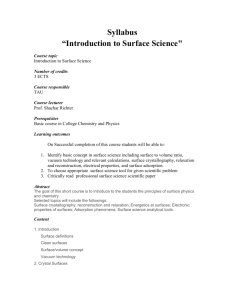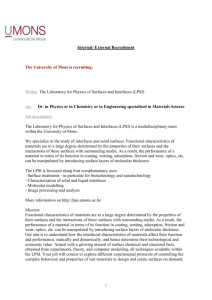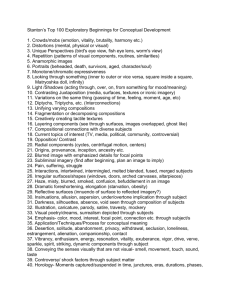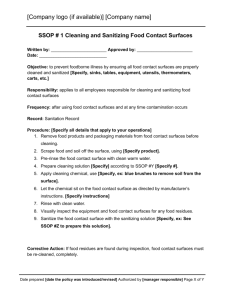15732 - School of Biological and Chemical Sciences
advertisement
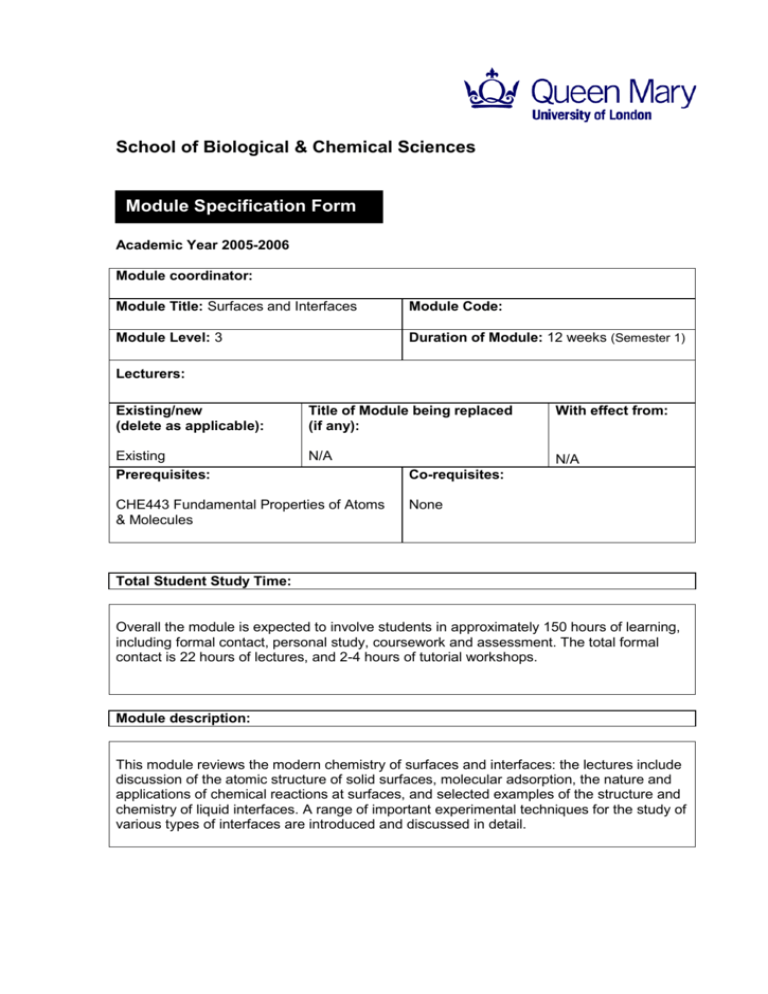
School of Biological & Chemical Sciences Module Specification Form Academic Year 2005-2006 Module coordinator: Module Title: Surfaces and Interfaces Module Code: Module Level: 3 Duration of Module: 12 weeks (Semester 1) Lecturers: Existing/new (delete as applicable): Title of Module being replaced (if any): With effect from: Existing Prerequisites: N/A N/A CHE443 Fundamental Properties of Atoms & Molecules Co-requisites: None Total Student Study Time: Overall the module is expected to involve students in approximately 150 hours of learning, including formal contact, personal study, coursework and assessment. The total formal contact is 22 hours of lectures, and 2-4 hours of tutorial workshops. Module description: This module reviews the modern chemistry of surfaces and interfaces: the lectures include discussion of the atomic structure of solid surfaces, molecular adsorption, the nature and applications of chemical reactions at surfaces, and selected examples of the structure and chemistry of liquid interfaces. A range of important experimental techniques for the study of various types of interfaces are introduced and discussed in detail. Aims: The aim of this course is to introduce and expand upon the important concepts underlying the current understanding and experimental investigation of the chemistry of surfaces and interfaces. The course examines the factors which influence the structure and reactivity of surfaces, and survey some of the modern experimental techniques used to study surfaces. At the end of this module students should appreciate the importance of interfacial processes (in areas such as catalysis and the electronics industry), understand key physical processes relating to surface chemistry, and be able to discuss the principles and merits of different experimental techniques for the study of interfaces. Intended Learning Outcomes: Subject knowledge and skills: At the end of this course students should; have a grasp of the importance and role of surfaces in a range of applications. have gained knowledge of surface structure, processes such as adsorption and desorption, and the reactivity at surfaces, and obtained experience in related numerical calculations. appreciate the importance of surface tension and its related applications. be able to select appropriate experimental techniques for investigation of specific properties, and discuss the physical basis, strengths and weaknesses of individual techniques. Core academic skills: This module will enhance students' understanding of the physical and chemical properties of surfaces, reactions at surfaces and methods for the characterisation of surfaces using a range of modern experimental techniques. They will also appreciate and gain a fundamental understanding of different processes, which are of great scientific and technological interest, occurring at surfaces. They will also gain an appreciation of the way in which scientific theories develop and are modified. Personal and key skills: The module will enhance students' general scientific understanding and knowledge of experimental techniques through lecture material. They will also see the real industrial applications of the material studied in the lectures. This is achieved by a series of four lectures given by an industrialist. Related course work will improve planning and organisational skills. Overall, the module will improve the students’ ability to handle information, to conduct independent study and to extract information from the scientific literature.. Module Specification Form: Surfaces and Interfaces. CHE635 2 Assignments/Coursework: The coursework will include one or more problem sheets, a class test (based on the lectures of Prof. Irven) and an essay on the current application of surface characterisation technique using current research journals. The coursework constitutes 20% of the final mark for the module and a minimum average coursework mark of 30% is required to pass the module at the first attempt, regardless of the performance in the examination. Attendance and Late submission of work: Attendance is required at all sessions in all parts of this course. Students who fail to attend at least 75% of each type of session may be barred from the final examination. A clear deadline for the submission of coursework will be given for each piece of assessed work. Work handed after the deadline will be corrected at the lecturers’ discretion but credit will only be given towards the assessment in exceptional circumstances. Assessment: Assessment methods: Assessment methods: Coursework (20%) and an examination paper in May/June (80%). Examination paper rubric: Answer FOUR questions ONE question from each sections A, B, C and D. Only permitted calculators may be used in this examination. Examination 2 hours and 15 minutes Laboratory work: N/A Oral: N/A Project: N/A Continuous Assessment Based on attendance requirement: N/A Dissertation: N/A Composite Written Exam: N/A Learning and teaching methods: Two lectures per week, supported by several tutorial workshops. Module Specification Form: Surfaces and Interfaces. CHE635 3 Syllabus Plan: Section I - Chemistry of the Solid-Gas Interface - Theory & Experiment 1) 2) 3) 4) 5) 6) 7) 8) 9) Introduction to surface chemistry and surface analysis Atomic structure of solid surfaces Adsorption of gases on surfaces Adsorption of gases on surfaces (cont.) Surface analysis - introduction X-ray photoelectron spectroscopy (XPS) Surface vibrational spectroscopy (EELS, RAIRS) Scanning tunnelling microscopy (STM) Thermal techniques and surface reaction kinetics Section II - Chemistry of Electronic, Opto-electronic and Optical Materials 10) Introduction to semiconductor materials and communications. 11) Electronic materials - the role of gases. 12) Opto-electronic materials and optics. 13) Fibreoptics technology and the future for CVD and chip technology. Section III – Surface characterisation using scattering techniques. 14) Introduction to the theory of X-ray and neutron scattering. 15) Production of X-ray and neutrons. 16) Theory of neutron and X-ray reflectivity. 17) Neutron and X-ray reflectometer. Application of the techniques. 18) Reflectivity data interpretation. 19) Introduction to the technique of ellipsometry and atomic force microscopy and its modes of operation. Examples of their applications. 20) Surface force apparatus and its application to determine the interaction forces between adsorbed polymer layers. 21) Introduction to surface tensions. 22) Experimental methods for measurement of surface tensions. Indicative Basic Reading List: For this course you must have access to a basic text on Physical Chemistry. The course is not tied to a single textbook. The followings are some useful books / reference material. 1) R.M. Nix, "An Introduction to Surface Chemistry" , web tutorial available at http://www.chem.qmul.ac.uk/surfaces/scc/ 2) G. Attard & C. Barnes, "Surfaces”, Oxford Chemistry Primer 59, QD508 ATT 3) E.M. McCash, "Surface Chemistry", Oxford, QD506 MAC. 4) Adamson & A.P. Gast, "The Physical Chemistry of Surfaces", 6th Edition, Wiley, QD506 ADA 5) A. Azzam, N.H. Bashara, "Ellipsometry and Polarised light", North-Holland, QC441 AZZ Module Specification Form: Surfaces and Interfaces. CHE635 4
